High Quality Data Drives Ecommerce in HVAC
The success of a PIM system is interdependent on the quality of well-organized product information. The main priority of a PIM system helps to create product catalogs for efficient distribution of product data. In today’s digital age, it is important to have engaging content that can attract new customers by highlighting critical product information. As a result, companies need to ensure that their content is well-organized and can be easily found across all interfaces.
PIM systems are most effective when they are integrated seamlessly into a business while implementing business best practices. A leading HVAC company ran into an issue when their e-commerce website was completely lacking technical product data, missing images, and inconsistent product descriptions. This led to the client losing e-commerce sales to their competitors who had a better website presence. At the time, the client was utilizing the PIM system Stibo. However, only one person seemed to understand the intricacies of Stibo. In turn, having one person understand the intricacies of a system, does not set up peers for success.
To get the company back on track, Convergence Data devised a phased approach plan to help correct these issues.
- The first phase was to update the product taxonomy with key missing product attributes.
- The second phase was to support the “go-live” of the Stibo/e-commerce platform with new product images and more consistent product descriptions.
- The third phase was to provide critical technical attributes that would find products online, seamlessly.
- The final phase was to publish enriched data to an online platform.
A quick win was to update the missing product descriptions and provide images for each product. That was put in place first while the team worked on updating their PIM schema with the missing critical technical attribute data. The client received an uptick in e-commerce activity just after updating descriptions and images.
Once Convergence Data helped to implement this process, the company saw an overall improvement in its e-commerce performance metrics. These metrics include conversion rates, order value, and cost per acquisition. We have provided a chart of some of the key findings that helped make a dramatic difference in e-commerce sales and conversions for this specific company.

If you are interested in reading more about our work in e-commerce especially in other industries, please read this case study in our e-commerce section of the website.
If you are experiencing any of these issues, please reach out to us so we help optimize your e-commerce platform.


